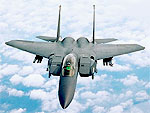Maintainers shine during first-ever Blue Flag
 UVDA AIR FORCE BASE, Israel -- Maintainers from Royal Air Force Lakenheath, England, used innovation and flexibility to ensure mission success during the first-ever Israeli Blue Flag exercise.
UVDA AIR FORCE BASE, Israel -- Maintainers from Royal Air Force Lakenheath, England, used innovation and flexibility to ensure mission success during the first-ever Israeli Blue Flag exercise.
Blue Flag, which took place Nov. 24-28, was a multinational aerial warfare training exercise hosted by the Israeli air force and included forces from the U.S., Israel, Italy and Greece. Its objectives were to improve operational capabilities and combat effectiveness of the participating nations, foster combined relations and cultural understanding, and gain combat experience.
However, before the U.S. Air Force could confirm its participation in the exercise, it had to be sure the location could accommodate the aircraft and support team.
"As a part of the advance team, we visited the base a couple months prior to the exercise to see if the base could accommodate the F-15s and support personnel," said Master Sgt. Jeremy Carlock, 48th Aircraft Maintenance Squadron production superintendent and maintenance project officer for Blue Flag. "I immediately noticed several challenges that we would have to adapt to for mission success."
One major challenge was the shape and size of the aircraft storage facilities. Due to the different types of aircraft used by the Israeli air force and the 492nd Fighter Squadron from RAF Lakenheath, the dimensions for the aircraft storage facilities were different than what the maintainers were used to.
"When I first saw the layout of the area where the aircraft would have to taxi in and out of, and also be stored, I wasn't sure it could be done," said Carlock. "It's an enclosed area which allowed minimal space for maneuvering aircraft, and there was not a lot of clearance to transport our jets in and out of the storage facilities. But, the team was able to adapt to the situation and mitigate all issues."
First-time deployer Airman 1st Class Kenneth Upshure, 48th AMXS avionics apprentice, was able to see firsthand how challenging work can be away from home station.
"Work conditions were definitely different here," said Upshure. "Due to limited space, if there was a problem with the jet, we had to fix it on the spot. We didn't have the luxury to transport it to a hangar like we do at home station. But I liked it; it was more challenging, faster paced and more pressure."
The maintainers planned for the worst possible conditions to ensure mission success. They selected and deployed an "A-team" capable of self-sustainment, which consisted of flightline and back-shop Airmen.
One of the back shops that were a part of the team was the fuels systems repair team.
"We were prepared to fix any issue with the aircraft fuels system," said Tech. Sgt. Travis Merriman, 48th Component Maintenance Squadron. "The unique working conditions here caused everyone to work in the same area. We adjusted and did our part to make sure the jets were mission-ready and the exercise was successful."
Success was an understatement. Airmen filled uncommon roles and assisted in areas that were different from their skill-set.
"When we weren't conducting any fuel system repairs, we helped out wherever we could," said Airman 1st Class Jacob Boot, 48 CMS fuels systems repair apprentice. "Due to the limited space, we helped marshal the jets in and out of the parking area. We made ourselves available to do anything we were asked to do."
The 48th Fighter Wing displayed its best for this first-ever Blue Flag exercise. Their professionalism and expertise proved to be essential for a successful training opportunity.